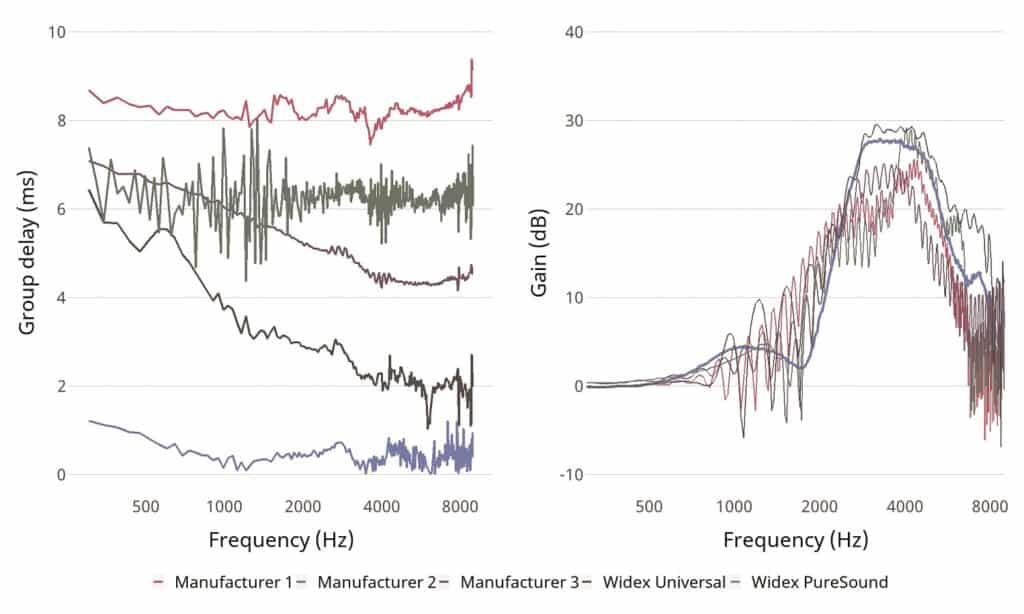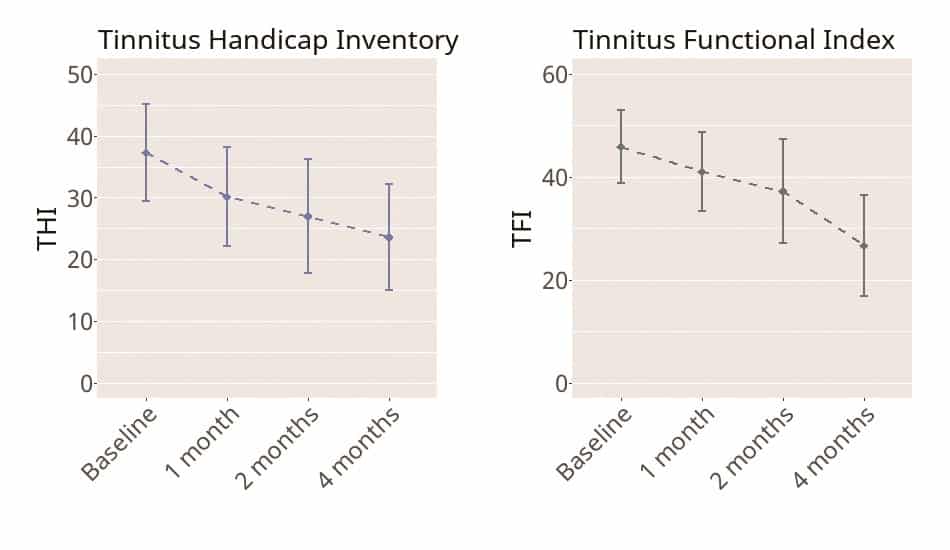The sound quality of Widex PureSound is tailored to people with milder hearing loss, including those with tinnitus.
By Laura Winther Balling, PhD, Renate Olinger, Anne Mette Jeppesen, MA, and Dana Helmink, AuD
Patients with mild hearing loss whose main complaint is tinnitus may benefit from amplification but object to the sound quality of hearing aids. For many, Widex PureSound, which has been optimized for mild-to-moderate hearing loss, can overcome the hurdle of poor sound quality. Combined with sound therapy options in Widex SoundRelax and Zen, this provides hearing care professionals with a strong and flexible offering for patients with tinnitus.
Imagine a patient whose main complaint is tinnitus but who also has a mild hearing loss. A main treatment option would be hearing aids,1–4 but what if the patient objects to the sound quality? This is not unlikely given that their hearing loss is mild and they are not primarily looking for amplification to solve an audibility issue. How can a hearing care professional (HCP) solve this sound quality problem?
A very attractive solution is to fit the patient with Widex PureSound™. This is an option in Widex Moment™ hearing aids in which the signal processing delay has been drastically reduced to eliminate artifacts and optimize sound quality for mild-to-moderate hearing loss. Combined with the sound therapy and relaxation options available in Widex SoundRelax™and Zen, an HCP has a broad palette of treatment options to help the tinnitus patient.5,6
Sound quality is crucial for many patients and is a major determinant of hearing aid satisfaction.7,8 The importance of sound quality is likely to be more pronounced for those with mild hearing losses.9 This makes Widex PureSound an ideal option for patients with mild-to-moderate hearing losses, including those whose main complaint is tinnitus rather than hearing loss.

Reducing delay for optimal sound quality
The key benefit of Widex PureSound hinges on the fact that the processing delay is radically reduced to an average of 0.5 ms. Premium hearing aids from other manufacturers operate with processing delays of 5 to 8 ms, as illustrated in the left panel of Figure 1 (for a detailed explanation of these differences, see 10). For open and vented fittings, this means that the delayed amplified signal is out of sync with the direct signal that reaches the ear through the vent. When two out-of-sync sound sources mix at the eardrum, they add up and cancel each other, creating a gain-frequency curve that resembles the teeth of a comb, as shown in the right panel of Figure 1.
The comb-filtering artifact results in a tinny, artificial hearing aid sound. It arises in open and vented fittings, which are generally worn by people with milder hearing losses, who are also more likely to hear the artifacts.11 With the ultra-low delay of Widex PureSound, this artifact is virtually absent, as illustrated by the smooth blue curve in the right panel of Figure 1.
The most obvious benefit of reducing processing delay is a sound quality advantage. The absence of comb-filtering artifacts results in better sound quality, which in turn results in a preference for lower delay across a wide range of situations, documented in lab,12 real-life,13 and hybrid studies.14
Other benefits of delay reduction
In addition to the sound quality advantage, the cleaner, less delayed signal of Widex PureSound also improves neural representation, spatial perception, and real-life experience.
Slugocki and colleagues15 investigated the effects of reducing delay on the brain response to speech, comparing the Envelope-Following Response (EFR) between Widex PureSound and two other premium hearing aids with longer delays. The study showed a more robust neural representation for Widex PureSound, which is associated with improved speech comprehension,16 better ability to identify a speaker’s voice,17 and easier extraction of target information from competing speech.18
Another benefit of reducing delay is that the spatial experience of listening through hearing aids may become more natural. This is because the processing delay in standard hearing aids may interfere with the timing of the room reflections—i.e., how the sound is reflected from surfaces in the room and how fast those reflections come back to the listener—which largely determines the auditory experience of a space. The delay in standard hearing aids may result in an unnatural sound that does not match the visual perception of the surroundings. By contrast, the ultra-low delay in PureSound preserves the timing of the room reflections for a more natural sound. This is supported by Korhonen and colleagues,19 who found that spatial discrimination was more accurate with Widex PureSound than with other premium hearing aids with longer delays.
Widex PureSound’s benefits have also been documented in real life. A survey of hearing-aid users13 wearing Widex PureSound showed higher ratings on a range of parameters that can be directly linked to delay, including naturalness and clarity of sound, accuracy of spatial perception, and naturalness of own voice. The survey also showed higher satisfaction with PureSound than other hearing aids in noisy situations. It is interesting that the less processed sound of PureSound also gives higher satisfaction in noise. A likely explanation is that the improved naturalness, robust neural representation, and accurate spatial experience make for a more pleasant listening experience in noisy environments.
Sound therapy for tinnitus treatment
Alongside amplification, the main treatment option for tinnitus is sound therapy (see, for an example,20). Both are part of the Widex Zen Therapy framework, together with counseling and relaxation techniques. The different elements may be used separately or together, depending on the patient’s preferences and severity of symptoms.
The sound therapy in Widex Zen Therapy is based on principles of fractal mathematics, with chime-like sounds that each have a recognizable quality but never repeat exactly. The original implementation of this is the Zen tones. Widex SoundRelax offers a new generation of fractal sounds that are softer, with improved interaural synchronization. Widex SoundRelax also includes wave-like sounds, which may be used alone or in combination with the tonal sounds. Zen was originally only implemented with Widex Universal, but with the introduction of Widex SoundRelax, fractal tones are also available with PureSound signal processing.
Specific Widex SoundRelax and Zen sounds are easily selected in the fitting software via default programs and are complemented by a wide range of options for customizing pitch, volume, and tempo. Patients can activate the sounds in their daily life for immediate and long-term relief from tinnitus.
Studies show the benefits of fractal sounds and the framework of Widex Zen therapy.6 A long series of studies published since 2010 show the benefits of fractal tones in themselves 21-23 and of the broader Widex Zen Therapy framework. 24-26

More recently, Balling and colleagues 5,27 investigated the new Widex SoundRelax sounds for different user groups. For a mixed group of listeners with and without tinnitus, the Widex SoundRelax sounds were rated highly for relaxation, concentration, and well-being,27 indicating their usefulness for reducing stress and improving well-being. Specifically for patients with bothersome tinnitus, a longitudinal study showed a significant improvement in tinnitus handicap after one month, which was sustained after two and four months of use,5 as illustrated in Figure 2.
Widex Zen Therapy is a multi-faceted framework for tinnitus treatment, which allows an HCP to combine different treatment elements (amplification, sound therapy, counseling, and relaxation techniques) for the individual patient, according to their unique needs and preferences. For amplification and sound therapy to reduce tinnitus distress, patients need to wear the hearing aid, which makes it important to optimize sound quality.
For patients with mild-to-moderate hearing loss—whose main complaint may be tinnitus— Widex PureSound, with its ultra-low signal processing delay and artifact-free sound, is an ideal solution. For those outside the PureSound fitting range, the Widex Universal program has been optimized for a wider range of hearing losses while still offering industry-leading signal processing delay for all wearers (Figure 1). For both signal processing strategies, many additional aspects besides delay have been tuned for optimal sound quality,10 with the aim of providing tinnitus sufferers and others with a better hearing life and improved well-being.HR

Laura Winther Balling, PhD, senior evidence and research specialist; Renate Olinger, M. communication pathology, audiology communication manager; and Anne Mette Jeppesen, MA, senior audiology solution manager, all work at Widex A/S in Lynge, Denmark. Dana Helmink, AuD, is senior director of audiological development at Widex US. Correspondence can be addressed to Dr Balling at [email protected].
References:
- Suzuki N, Shinden S, Oishi N, et al. Effectiveness of hearing aids in treating patients with chronic tinnitus with average hearing levels of <30 dBHL and no inconvenience due to hearing loss. Acta Otolaryngol. 2021;141(8):773-779.
- Simonetti P, Vasconcelos LG, Gândara MR, Lezirovitz K, Medeiros, RT de, Oiticica J. Hearing aid effectiveness on patients with chronic tinnitus and associated hearing loss. Braz J Otorhinolaryngol. 2022;88:S164-S170.
- Del Bo L, Ambrosetti U. Hearing aids for the treatment of tinnitus. Prog Brain Res. 2007;166:341-345.
- Shinden S, Suzuki N, Oishi N, Suzuki D, Minami S, Ogawa K. Effective sound therapy using a hearing aid and educational counseling in patients with chronic tinnitus. Auris Nasus Larynx. 2021;48(5):815-822.
- Balling LW, Caporali S, Parker D, Jeppesen AM, Helmink D. Expanding Options for Effective Tinnitus Management. The Hearing Review. 2023;30(2):12-16.
- Balslev D. A Compilation of Widex Zen Therapy Evidence. WidexPress. 2017;37.
- Bannon L, Picou EM, Bailey A, Manchaiah V. Consumer Survey on Hearing Aid Benefit and Satisfaction. Journal of Speech, Language, and Hearing Research. Published online March 21, 2023;1-18.
- Picou EM. MarkeTrak 10 (MT10) Survey results demonstrate high satisfaction with and benefits from hearing Aids. Semin Hear. 2020;41(1):21-36.
- Strom K. Blog: Sound quality as a tipping point for the younger, milder hearing loss market. Sept 20, 2020. Available at: https://hearingreview.com/hearing-products/hearing-aids/otc/sound-quality-and-the-younger-milder-hearing-loss-market.
- Balling LW, Mosgaard LD, Helmink D. Signal processing and sound quality. The Hearing Review. 2022;29(2):20-23.
- Stiefenhofer G. Hearing aid delay in open-fit devices–coloration-pitch discrimination in normal-hearing and hearing-impaired. Int J Audiol. 2022;0(0):1-9.
- Lelic D, Stiefenhofer G, Lundorff E, Neher T. Hearing aid delay in open-fit devices: Preferred sound quality in listeners with normal and impaired hearing. JASA Express Lett.
2022;2(10):104803. - Balling LW, Townend O, Helmink D. Sound quality for all: The benefits of ultra-fast signal processing in hearing aids. The Hearing Review. 2021;28(9):32-35.
- Balling LW, Townend O, Stiefenhofer G, Switalski W. Reducing hearing aid delay for optimal sound quality: a new paradigm in processing. The Hearing Review. 2020;27(4):20-26.
- Slugocki C, Kuk F, Korhonen P, Ruperto N. Neural encoding of the stimulus envelope facilitated by Widex ZeroDelay technology. The Hearing Review. 2020;27(8):28-31.
- Song JH, Skoe E, Banai K, Kraus N. Perception of speech in noise: neural correlates. 2011.
- Baumann O, Belin P. Perceptual scaling of voice identity: common dimensions for different vowels and speakers. Psychol Res. 2010;74:110-120.
- Summers V, Leek MR. F0 processing and the separation of competing speech signals by listeners with normal hearing and with hearing loss. Journal of Speech, Language, and Hearing Research. 1998;(41):1294-1306.
- Korhonen P, Kuk F, Slugocki C, Ellis G. Low processing delay preserves natural cues and improves spatial perception. The Hearing Review. 2022;29(6):20-25.
- Henry JA, Carlson KF, Theodoroff S, Folmer RL. Reevaluating the use of sound therapy for tinnitus management: perspectives on relevant systematic reviews. Journal of Speech, Language, and Hearing Research. 2022;65(6):2327-2342.
- Herzfeld M, Kuk F. A clinician’s experience with using fractal music for tinnitus management. The Hearing Review. 2011;18(11):50-55.
- Kuk F, Peeters H, Lau CL. The efficacy of fractal music employed in hearing aids for tinnitus management. The Hearing Review. 2010;17(10):32-42.
- Sweetow R, Kuk F, Caporali S. A controlled study on the effectiveness of fractal tones on subjects with minimal need for amplification. The Hearing Review. 2015;22(9):30-34.
- Herzfeld M, Ciurlia-Guy E, Sweetow RW. Clinical trial on the effectiveness of Widex Zen Therapy. The Hearing Review. 2014;21(11).
- Johansen JD, Skellgaard PH, Caporali S. Effect of counseling, amplification and fractal tones in tinnitus management. Journal of Communication Disorders, Deaf Studies & Hearing Aids. 2014;02(04).
- Stocking CT, Stecker NA. Efficacy of the individual components of a tinnitus management protocol. Audiology Online. 2016;Article 18326.
- Balling LW, Caporali S, Parker D, Jeppesen AM, Helmink D. Are Hearing aids the answer to reducing stress and improving well-Being? The Hearing Review. 2022;29(8):24-27.
- Newman CW, Jacobson GP, Spitzer JB. Development of the tinnitus handicap inventory. Archives of Otolaryngology-Head and Neck Surgery. 1996;122(2):143-148.
- Meikle MB, Henry JA, Griest SE, et al. The tinnitus functional index: development of a new clinical measure for chronic, intrusive tinnitus. Ear Hear. 2012;33(2):153-176. Accessed December 6, 2022. Available at: https://journals.lww.com/ear-hearing/Fulltext/2012/03000/The_Tinnitus_Functional_Index__Development_of_a.2.aspx





